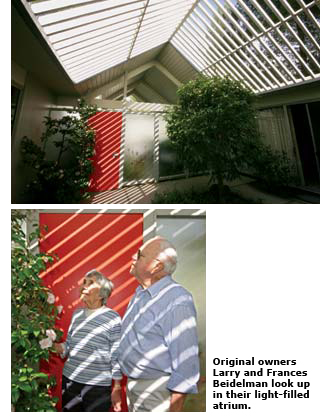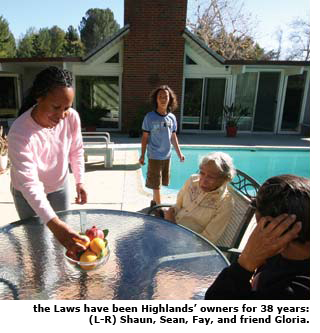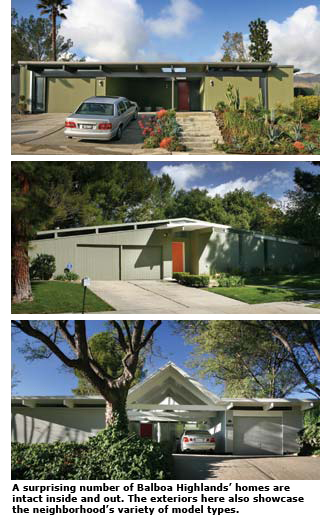The Eichlers of Balboa Highlands - Granada Hills - Page 2
Pascual points out another advantage of going Hollywood: "Those guys eat well. Steak lunches—and fish. They had real steaks cooking on the grill for the entire crew." And they shared with the homeowners. Pascual and Huntley, whose Eichler would resemble a museum of classic modern furniture if it weren't so livable, spent three years restoring it. "We wanted the home to look like it did back in 1963," Pascual says.
The Blocks' house, which had been in foreclosure when they bought it, also required heroic intervention. "It was a wreck," Adeline recalls. They restored what they could and added features to harmonize with the original, including porcelain tile flooring, and cabinetry that matches the 'flying coffin' cabinet that floats above the cook top. Their house, which was included on the 'How Modern Was My Valley' home tour, was one of the houses that inspired neighbors to restore their own homes.

"Most properties that have sold in the last five years have been to people who are into mid-century modern, who maintain and try to re-gentrify them," Adeline says. "That is the trend. There are exceptions. Some [houses] have already been so altered, there's no going back." A surprising number of homes, however, are essentially intact inside and out, including that of original owners Larry and Frances Beidelman, who chose their Jones & Emmons A-frame model in 1963. Some neighbors call the Beidelmans' "the museum house." Even their stove is original.
Neighbors Edgar and Fay Law have watched for 38 years as neighbors altered their houses, sometimes beyond recognition. In 2005, Biondo urged the Los Angeles City Council to issue an 'interim control ordinance' to prevent further ill-considered changes while the neighborhood sought historic designation. The ordinance requires review by the Los Angeles Planning Department before issuing building permits.
Biondo, who has been working for four years on the historic designation—called an 'HPOZ, for 'historic preservation overlay zone'—believes it will be awarded next year. If Balboa Highlands earns the designation—the decision is ultimately up to the Los Angeles City Council—it will be the city's 23rd historic district. The only other postwar neighborhood that made the cut is architect Gregory Ain's Mar Vista, in Venice, built between 1946 and 1948.
Jay Platt, preservation advocate for the Los Angeles Conservancy, believes the neighborhood will qualify. "To my eyes," he says, "most of the buildings in Balboa Highlands contribute" to the neighborhood's historic character. The designation will allow owners of 'contributing' houses to apply for property tax reductions under the state's Mills Act.

The designation would restrict exterior changes to homes, based on guidelines that would be developed following neighborhood hearings. There would be no restrictions on interior changes. Additions and alterations would still be permitted, Platt says. A board made up primarily of residents knowledgeable about the neighborhood's architecture and history, and including at least one architect, would review proposed alterations.
Biondo says support for historic designation in the neighborhood is strong. David Block, who worries that oversight could be too strict, likes the idea—in concept. "If it can prevent people from destroying the look of the neighborhood, we're all for that," he says.
Balboa Highlands' history involves more than architecture. In the San Fernando Valley, one of America's greatest postwar swaths of suburban sprawl, the neighborhood won fame for being among the first integrated communities.
The Laws, who are African-American, first moved to a different part of the valley, in 1967. They recall neighbors who threw eggs at their house and killed their cat. Edgar Law, an architect who had helped develop low- and moderate-cost housing in the Bay Area for the city of Richmond's redevelopment agency, knew about Eichler's commitment to integration. So when his wife Fay discovered there were Eichlers in the valley, they jumped. They never ran into racial problems at Balboa Highlands, which was home to a couple of other African-American families and many Asians. Both Laws were involved with the Fair Housing Council, Fay editing its newsletter.

The Balboa Highlands' neighborhood was rural in the mid-'60s, with orange groves stretching between the tract and the mountains. "We never bought any fruit," Edgar remembers. There were no freeways.
The neighborhood had always been tied to Hollywood, however. The area was once home to celebrity 'ranches' owned by Jimmy Cagney, John Wayne, and other stars.




